
If you have ever been to a dentist for a routine checkup, you may have come across a dental handpiece.
They are not only used by dentists but also by lab technicians, hygienists, and specialists.
They vary in type. Some are designed to perform several procedures while some may only come in handy for specific ones.
This is why you need to know what type of handpieces you need for specific procedures.
Don’t worry! This article has you covered.
Learn about the parts of the handpiece as well as the different types so that you can make the right choice.

Dental Handpiece Uses
When you go to the dentist, you will see certain instruments such as the dental mouth mirror and the handpiece.
You may be unaware of what it is called but you have certainly seen a pen-like instrument attached to the dental chair.
The name for this dental instrument is a dental drill handpiece.
One of the uses of a handpiece is to clean your teeth.
Hence, the dentist uses it on patients while performing scaling.
It helps to remove tartar and plaque buildup on your teeth.
However, its only purpose is not limited to cleaning your teeth.
The handpiece helps to prepare the tooth for a dental procedure such as crown placements and filling.
On the other hand, it also cleanses the tooth off decay by removing the damaged part of the tooth.
Just like fillings and crowns, it also helps to prepare the tooth for a root canal.
Moreover, you can attach different burs on its head to clean, polish, or cut the teeth as you require.
As a dental practitioner, choosing the kind of handpiece depends on what treatments you offer to your patients.
Though, your ease of use and comfort also matters.
Hence, you need to choose the handpiece while keeping in mind its components and types.

Components and Parts of Dental Handpiece
Heads
The head of the handpiece is the tip of the instrument which includes the chuck and ath attachment of the bur.
The heads you choose should be compatible with the handpiece.
There will be specialized heads for endodontics, operative dentistry, and hygiene.
Thus, you can use the handpiece for several dentistry procedures by using different heads.
Plus, they are easy to clean and sterilize.
Swivels
Swivels and swivel accessories facilitate the dentist in using the handpiece without any drag from the cord.
Hence, there is an ease of motion and it prevents the cord from tangling or getting caught.
These accessories attach to the handpiece using 6 pin or 4 pin connections.
They have fiber optic or LED lighting.
While purchasing, make sure that the handpiece swivel is fully autoclavable.
This prevents cross-contamination between patients.
Lights
The LED cool light provides enough illumination inside the mouth to examine and treat it for oral health problems.
Fiber optics generate the light source in handpieces.
The new LED lights are more efficient than halogen lights and are quickly replacing them.
They can last 10 times as long.
Moreover, halogen lights give off more heat so LED lights are in popular use now also for their intense light.
Besides these, there are types of handpieces that are broadly divided into two categories.
That is the speed and design. More on that below!
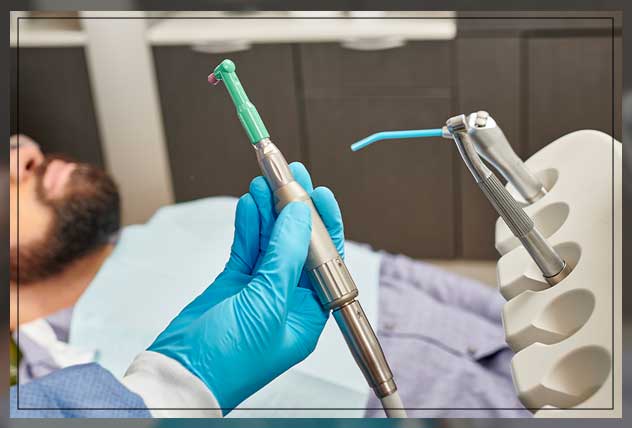
Dental Handpiece Types
Design of a Handpiece- Electric vs Air Driven
Powering a handpiece could be through two ways, electric or air turbine.
Now electric handpieces simply use an electric motor to power the head and it has its system in the form of an electric motor.
The internal gears allow the motor to run at a consistent power and torque with a speed of 200,000 rpm.
Many electric motors support the contra-angle and straight handpieces.
Plus, some models contain two motors that allow the alternating between low speed and high speed.
It has high torque, and precision cutting, that too with less vibration and less noise overall.
Moreover, the electrical handpieces can be integrated into computer systems or touchpads.
When it comes to air-driven instruments, it contains a spinning turbine.
Compressed air powers it to generate the rotation.
It can speed up to 400,000 rpm with a changeable torque.
Pressured air and water act as a coolant and it also has a light source which can be helpful while using these motors.
Contra angle and straight handpieces can be used as on-air turbine handpieces.
While purchasing, make sure you know if the motor can connect to handpieces from different vendors.
However, air-driven handpieces are noisier.
The turbine produces a high-pitched sound.
Similarly, its speed consistency is not as good as that of an electric motor.
Though, electrical handpieces are pricier.
It has a system different from the rest of the dental equipment.
Hence, it can cost more than an air-driven handpiece.
Speed of a Handpiece
A high-speed handpiece can run at a speed of 250,000 rpm to 400,000 rpm.
Low-speed handpieces run between 100 to 140,000 pm.
The average speed is usually around 800,000 RPMs.
They may also be different in material, design, and form.
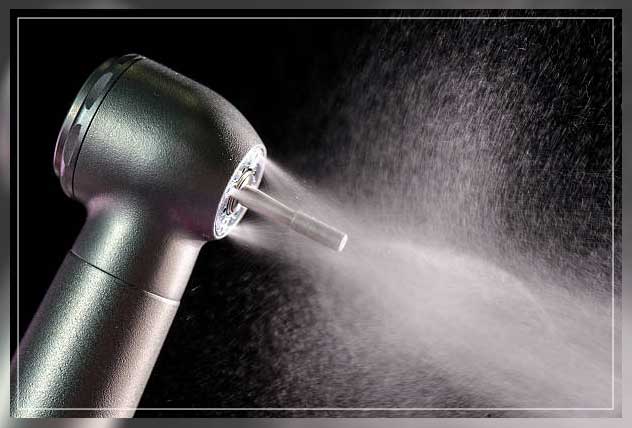
High Speed and Low-Speed Dental Handpiece
High-Speed Air-Driven
The high-speed air-driven handpieces are precision devices.
Hence, they can remove the enamel and tissue rapidly without heat, vibration, or pressure.
They can remove tooth structure, prepare the tooth for crowns and fillings, section a tooth in surgeries, and create margins.
Due to its high speed, it can cut through things sharply.
However, they are quite louder than slow handpieces.
It has a curved appearance and head angulation that can differ for handpieces.
High-speed handpieces use an additional item – bur.
The dental handpiece bur is essentially a rotatory instrument with a grip.
It can vary in material, shape, and design among brands but its speed will remain consistent.
It runs at 180,000 and 450,000 pm.
Moreover, it contains a water spray that acts as a coolant because it produces heat.
The water sprays delivered through a multi-port prevent the overheating of the pulp.
Other than that, there is a large head with better cutting power and torque also a small head for better visibility and for working on the posterior teeth and children.
It also has attachments like a light source, motor noise, head size, type, and handpiece weight.
Low-Speed Air-Driven
It spins the prophy cup and dental bur at only 50,000 rpm.
The typical speed can be up to 80,000 rpm.
Its main use is in treating soft decay, trimming, refining the cavity preparation in root canal treatments and endodontic procedures, and polishing.
The attachment varies by design.
For instance, straight attachments connect to the motor base plus are used for extraoral procedures like trimming dentures.
Contra angle attachments can remove decay and do finer work as the burs vibrate less.
Prophylaxis angle attachments hold the bristle brush and trophy cup for cleaning and polishing.
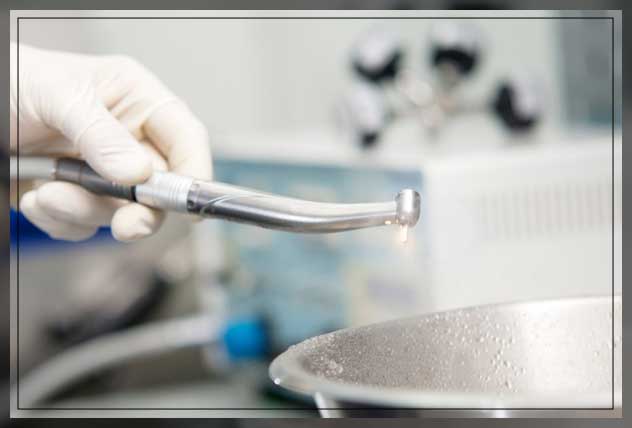
Other Types
Besides the high speed and low-speed air-driven handpieces there exist:
- Implant Handpiece
- Surgical Handpiece
- Electric Handpiece
- Endodontic Handpiece
Implant
These are particularly designed for oral and maxillofacial surgery.
It is made from high-quality stainless steel along with a special coating.
This makes them especially stronger.
Surgical
An important tool for oral surgeries is the surgical handpiece.
This is an air-driven handpiece with grated vents.
This feature prevents air from spaying in your oral cavity during a surgical procedure.
Hence, preventing complications and ensuring the safety of the procedure.
Electric
These contra-angle tools work faster, more accurately, have a high speed, and less noise.
Hence, they can save time and the motorized torque increases precision.
It allows dentists to work comfortably in tough angles and where space is tight.
Plus, they come in different styles and help you save money for additional purchases.
Dentists may prefer to replace their old air-driven handpieces with that of an electric ones.
Endodontic
This instrument is for specific use.
It helps to clean and shape the canals in a root canal procedure.
It comes in use to use endodontic files with precision.
Moreover, it prevents file breakage and binding.
It works with your preferred file system and operator equipment for better precision.
Now that you know the types of handpieces, let’s find out what you should consider while purchasing one.

Considerations While Making a Purchase
When choosing the best dental handpiece for your practice, you should consider its:
- material
- lights
- warranty
- noise
- country of origin
- budget
You can recognize a good handpiece by its material.
Look out for bodies of titanium that are stronger and more durable.
Choose ceramic bearings that are hard-wearing and smart coatings for better grip.
Now handpieces also have an integrated light to illuminate the intraoral area.
There are two options, halogen lights or LED lights.
LED lights are in popular use due to their better intensity, longer working period, and less heat.
Always check for a warranty while purchasing medical equipment, tools, and instruments.
If problems arise, this can come in used to save additional expenses.
Warranty will usually last for 12, 18, or 24 months.
Another important aspect to look out for is noise.
A louder noise can be off-putting for the patient as well as the dentist.
This may hinder the procedure.
Air-driven handpieces are noisier and air turbines generate vibration.
This is the sound of compressed air.
Whereas, the electric ones are way less noisy and do not produce vibration.
No purchase is possible without a budget.
However, it should certainly not be the only deciding factor.
Look for quality and efficiency.
A reasonably priced equipment will last you longer than a cheaper one.
Thus, keep all these factors in consideration while making a purchase.
Also,
You can get dental handpieces for sale at our site.
These are affordable and efficient handpieces that will facilitate your practice for a long period.
Check our shop to look into more products.


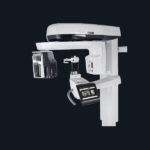
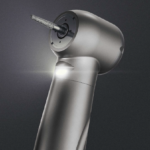
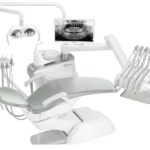
Comments